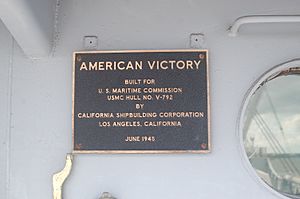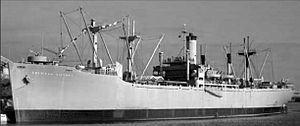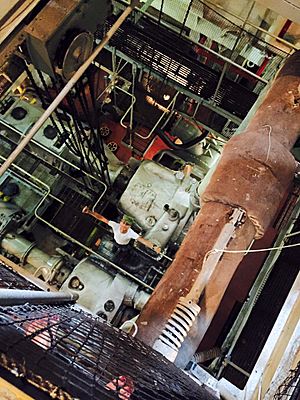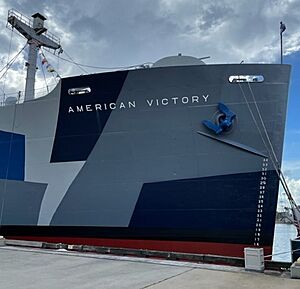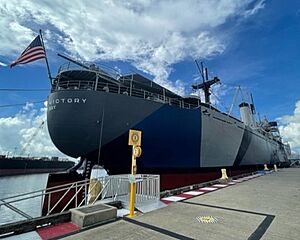SS American Victory facts for kids
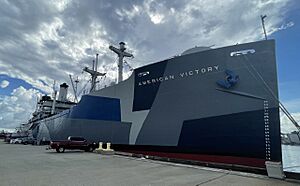 |
|
| History | |
|---|---|
| Namesake | American University |
| Builder | California Shipbuilding Yard, Los Angeles, California |
| Yard number | 272 |
| Laid down | 30 March 1945 |
| Launched | 24 May 1945 |
| Acquired | 20 June 1945 |
| In service | 1945 |
| Out of service | 1969 (Final) |
| Identification | IMO number: 5014680 |
| Status | Museum Ship, Tampa, Florida |
| Notes | Ship radio callsign: KKUI |
| General characteristics | |
| Class and type | VC2-S-AP2 Victory Ship |
| Tonnage | 10,750 long tons deadweight (DWT) |
| Length | 455 ft (139 m) |
| Beam | 62 ft (19 m) |
| Draft | 28 ft 6 in (8.69 m) |
| Propulsion |
|
| Speed | 17.5 knots (32.4 km/h; 20.1 mph) |
| Range | 23,500 mi (20,400 nmi; 37,800 km) |
| Capacity | 500,000 cu ft (14,000 m3) (approximate) |
| Complement | 40-62 United States Merchant Marine plus 25 United States Navy Armed Guard (during WWII only). |
| Sensors and processing systems |
Modern Surface Search Radar, fitted in 1980s |
| Armament |
|
| Location | 705 Channelside Dr, Berth 271, Tampa, Florida |
| Built | 1945, in just three months |
| Built by | California Shipbuilding Corporation, Terminal Island, Los Angeles, CA |
| NRHP reference No. | 01001533 |
| Added to NRHP | 4 February 2002 |
The SS American Victory is a special kind of cargo ship called a Victory ship. These ships were built very quickly during World War II to carry supplies. The American Victory helped out in the final months of World War II, then later in the Korean War (1951-1954), and the Vietnam War (1966-1969).
This ship was built in June 1945. It carried important cargo like ammunition from Los Angeles to places in Southeast Asia. After the wars, it brought cargo, equipment, and even troops back to the United States. It's a tough ship, having survived two typhoons and one hurricane!
For many years, the American Victory was used by commercial companies or kept in special "reserve fleets." These fleets are like parking lots for ships, keeping them ready for future use.
In 1999, a group took over the ship to save it. Now, it's a museum ship in Tampa, Florida. You can visit it and learn about its amazing history at the American Victory Ship & Museum.
Contents
A Ship's Journey Through Wars
World War II Adventures
The ship was named after American University in Washington, D.C.. It was built super fast at the California Shipbuilding Corporation in Los Angeles, California. It took only 55 days to build the main part, and then about another month to get it ready for sea.
The American Victory was delivered on June 20, 1945. It was a United States Merchant Marine ship, meaning it was operated by civilian sailors. It carried supplies for the United States Army from ports on the west coast of the U.S. to Manila in the Philippines.
The war ended while the ship was in Manila. After that, it took its remaining cargo to Shanghai, China. For the next two months, it sailed around the South China Sea and the Bay of Bengal.
In November 1945, the American Victory sailed to places like Calcutta and Port Said, Egypt. It was loaded with military cargo that needed to be returned to the United States. It arrived in New York in January 1946, finishing its first big journey.
Helping Europe After the War
After World War II, from 1946 to 1947, the American Victory helped with the Marshall Plan. This was a big U.S. program to help rebuild Europe after the war. The ship carried food and machinery from the United States to countries in Europe, Russia, and the Near East.
It visited many ports, including Trieste, Italy, Constanza, Romania, Piraeus, Greece, and Antwerp, Belgium. In January 1947, while leaving Odesa, Ukraine, the Black Sea was frozen solid. Instead of waiting for a Soviet icebreaker ship, the captain, A. D. Cushman, decided to use the American Victory itself to break the ice! He backed up and rammed the ice, clearing a path for his ship and others to leave the Black Sea.
After this, the ship was stored in the Hudson River Reserve Fleet. It was then used again during the Korean War from 1951 to 1954. After that, it went into another reserve fleet in the Sabine River in Texas.
Serving in Korea and Vietnam
In 1963, there were plans to change the American Victory and 14 other ships into "forward depot" vessels. These ships would be loaded with military supplies and stationed near important areas. This way, American forces would have supplies ready quickly. However, this plan was canceled in 1966.
The American Victory was taken out of the Sabine River Reserve Fleet in 1966. It then carried military equipment to American forces fighting in South Vietnam. After this service, it was put back into a reserve fleet in Lees Hall, Virginia, in October 1969. It stayed there until 1985.
The ship was then fixed up as part of a project to see how much work it would take to get these older ships ready for service again. After spending $2.5 million to make it fully working, it sailed for just 26 hours before returning to the Naval Reserve Fleet.
Life as a Museum Ship Today
In the late 1990s, many World War II Victory ships were going to be taken apart for scrap metal. But the American Victory was saved by people who wanted to preserve it. It arrived in Tampa, Florida, in September 1999, to start its new life as a museum ship.
After a lot of work, the ship was fully working again by 2003. It is now open for visitors and is listed on the National Register of Historic Places. This means it's recognized as an important historical site.
You can take guided or self-guided tours of the ship. Most areas are open, like where the officers, crew, and gunners lived. You can also see the kitchen (galley), dining areas, cargo holds, the wheelhouse (where the ship is steered), the radio room, and the hospital. These areas have been restored to look like they did during the ship's active years.
The American Victory has been updated with modern equipment like a new VHF radio and radar. But it still looks mostly like it did in the past. It has its original-style guns, including a 3-inch gun at the front and a 5-inch gun at the back.
The American Victory is still a fully working ship that can sail! With some preparation, it can cruise in Tampa Bay. The U.S. Coast Guard checks the ship twice a year to make sure it's safe for visitors.
Out of the 534 Victory ships ever built, only three are open to the public today. These are the American Victory in Tampa, SS Lane Victory in Los Angeles, and SS Red Oak Victory in Richmond, California.
Cool Things to See Onboard
The ship has many interesting exhibits in its No. 3 cargo hold. This area was turned into a museum space. One cool exhibit is an actual propeller from a German submarine, the German submarine U-352. This submarine was sunk in 1942 and its propeller was found in 1979. You can see photos of the shipwreck, a model of a German sailor, and diagrams of other submarines.
There are also many models of different ships, including a Clemson-class destroyer, a Fletcher-class destroyer, and a German Type VII U-boat.
You can also find old posters used to recruit sailors for the Merchant Marine. There's a collection of plaques from other Victory and Liberty ships that were either sunk or scrapped. Plus, there's a pretend ship's wheelhouse, a lifeboat, and an exhibit about maritime signal flags.
Ship Awards
- Victory Medal
- Pacific War Zone Bar
- Philippine Liberation Ribbon
- Korean Service Ribbon
- Vietnam Service Ribbon
See also
- SS Maritime Victory, another Victory ship that was changed into a troopship
- SS Lane Victory
- SS Red Oak Victory


